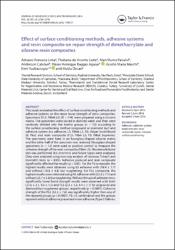Effect of surface conditioning methods, adhesive systems and resin composite on repair strength of dimethacrylate and silorane resin composites

Göster/
Erişim
info:eu-repo/semantics/openAccessTarih
2016Yazar
Lima, Adriano FonsecaLeite, Thatiana de Vicente
Palialol, Alan Muniz
Catelan, Anderson
Baggio Aguiar, Flavio Henrique
Marchi, Giselle Maria
Yüzbaşıoğlu, Emir
Özcan, Mutlu
Üst veri
Tüm öğe kaydını gösterKünye
Lima, A. F., Leite, T. V., Palialol, A. M., Catelan, A., Baggio Aguiar, F. H., Marchi, G. M. ... Özcan, M. (2016). Effect of surface conditioning methods, adhesive systems and resin composite on repair strength of dimethacrylate and silorane resin composites. Journal Of Adhesion Science And Technology, 30(24), 2736-2744. https://dx.doi.org/10.1080/01694243.2016.1199217Özet
This study evaluated the effect of surface conditioning methods and adhesive systems on the repair bond strength of resin composites. Specimens (FLS: Filtek LS) (N = 144) were prepared using a silicone matrix. The specimens were stored in distilled water and then were randomly divided into the twelve groups (n = 12) according to the surface conditioning method (unground or diamond bur) and adhesive system (no adhesive, LS: Filtek LS, AS: Adper Scotchbond SE Plus) and resin composite (FLS: Filtek LS; FS: Filtek Supreme). The specimens were fixed in an hourglass-shaped silicone matrix and the other half of the specimen was restored. Hourglass-shaped specimens (n = 12) were used as positive control to measure the cohesive strength of the resin composite (Filtek LS). Microtensile bond test was performed (0.5 mm/min) and failure types were analyzed. Data were analyzed using two-way analysis of variance, Tukey's and Dunnett's tests (alpha = 0.05). Adhesive protocol and resin composite significantly affected the results (p < 0.05). For the FS composite, the highest results were obtained using LS adhesive with (18.4 +/- 7.7) and without (18.8 +/- 4.8) bur roughening. For FLS composite, the highest results were obtained using AS adhesive with (33.2 +/- 7.1) and without (25.7 +/- 3.6) bur roughening. Without the use of adhesive resin, significantly lower bond strength results were observed with both LS (5 +/- 2.1, 4.5 +/- 1.5) and FLS (2.2 +/- 1.2, 4.4 +/- 1.1) for unground and diamond bur roughened groups, respectively (p < 0.0001). Cohesive strength of the FLS (52.3 +/- 7.6) was significantly higher than any of the repaired groups (p < 0.0001). FS-LS combination and the groups repaired without adhesive presented more adhesive (Type I) failures.
WoS Q Kategorisi
Q3Scopus Q Kategorisi
Q2Kaynak
Journal Of Adhesion Science And TechnologyCilt
30Sayı
24Koleksiyonlar
- Makale Koleksiyonu [558]
- Scopus İndeksli Yayınlar Koleksiyonu [6522]
- WoS İndeksli Yayınlar Koleksiyonu [6585]

















